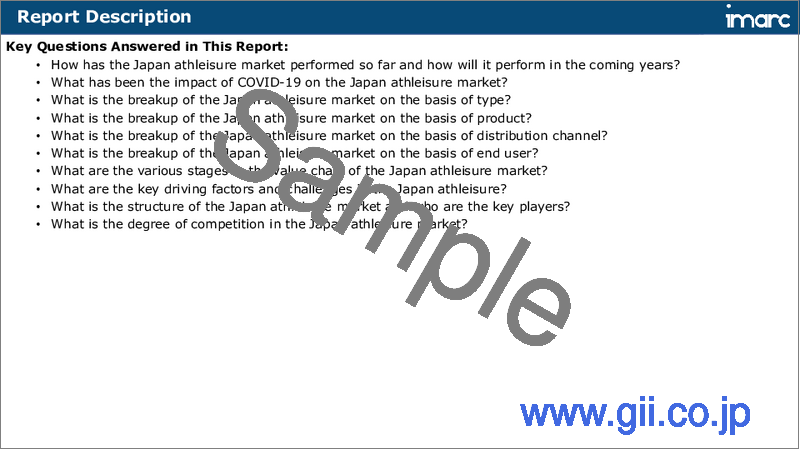|
|
市場調査レポート
商品コード
1729503
日本のアスレジャー市場レポート:タイプ、製品、流通チャネル、エンドユーザー、地域別、2025年~2033年Japan Athleisure Market Report by Type (Mass Athleisure, Premium Athleisure), Product (Yoga Apparels, Shirts, Leggings, Shorts, and Others), Distribution Channel (Online, Offline), End User (Men, Women, Children), and Region 2025-2033 |
||||||
カスタマイズ可能
|
|||||||
| 日本のアスレジャー市場レポート:タイプ、製品、流通チャネル、エンドユーザー、地域別、2025年~2033年 |
|
出版日: 2025年05月01日
発行: IMARC
ページ情報: 英文 118 Pages
納期: 5~7営業日
|
全表示
- 概要
- 目次
日本のアスレジャー市場規模は2024年に238億米ドルに達しました。今後、IMARC Groupは、市場は2033年までに381億米ドルに達し、2025年から2033年にかけて5.4%の成長率(CAGR)を示すと予測しています。環境に優しく持続可能なファッションへの注目の高まりが、アスレジャーブランドにより持続可能な素材と実践の採用を促しており、これが主に市場を牽引しています。
本レポートで扱う主な質問
- 日本のアスレジャー市場はこれまでどのように推移し、今後どのように推移するのか?
- COVID-19が日本のアスレジャー市場に与えた影響は?
- 日本のアスレジャー市場のタイプ別区分は?
- 日本のアスレジャー市場の製品別区分は?
- 日本のアスレジャー市場の流通チャネル別内訳は?
- 日本のアスレジャー市場のエンドユーザー別の区分は?
- 日本のアスレジャー市場のバリューチェーンにおける様々なステージとは?
- 日本のアスレジャーの主な促進要因と課題は?
- 日本のアスレジャー市場の構造と主要プレーヤーは?
- 日本のアスレジャー市場における競合の程度は?
目次
第1章 序文
第2章 調査範囲と調査手法
- 調査の目的
- ステークホルダー
- データソース
- 市場推定
- 調査手法
第3章 エグゼクティブサマリー
第4章 日本のアスレジャー市場:イントロダクション
- 概要
- 市場力学
- 業界動向
- 競合情報
第5章 日本のアスレジャー市場情勢
- 過去および現在の市場動向(2019~2024年)
- 市場予測(2025~2033年)
第6章 日本のアスレジャー市場:タイプ別内訳
- マスアスレジャー
- プレミアムアスレジャー
第7章 日本のアスレジャー市場:製品別内訳
- ヨガウェア
- シャツ
- レギンス
- ショートパンツ
- その他
第8章 日本のアスレジャー市場:流通チャネル別内訳
- オンライン
- オフライン
第9章 日本のアスレジャー市場:エンドユーザー別内訳
- 男性
- 女性
- 子供
第10章 日本のアスレジャー市場-競合情勢
- 概要
- 市場構造
- 市場企業のポジショニング
- 主要成功戦略
- 競合ダッシュボード
- 企業評価象限
第11章 主要企業のプロファイル
第12章 日本のアスレジャー市場:業界分析
- 促進要因、抑制要因、機会
- ポーターのファイブフォース分析
- バリューチェーン分析
第13章 付録
Japan athleisure market size reached USD 23.8 Billion in 2024. Looking forward, IMARC Group expects the market to reach USD 38.1 Billion by 2033, exhibiting a growth rate (CAGR) of 5.4% during 2025-2033. The increasing focus on eco-friendly and sustainable fashion that has prompted athleisure brands to adopt more sustainable materials and practices, is primarily driving the market.
Athleisure, a fusion of athletic and leisure, represents a contemporary fashion trend that has transcended gym walls to become a lifestyle choice for many. This style effortlessly marries the comfort and functionality of sportswear with the versatility and aesthetic appeal of casual clothing. Athleisure garments often include yoga pants, leggings, hoodies, sneakers, and other sporty attire, all designed to make a seamless transition from the gym to everyday life. One of the driving forces behind the popularity of athleisure is the growing emphasis on wellness and fitness in modern society. People now seek clothing that accommodates their active lifestyles while still keeping them fashionable and comfortable. Athleisure wear caters to this demand, offering a wide range of designs, colors, and fabrics to suit various preferences and occasions. Beyond its convenience and comfort, athleisure has also reshaped the fashion industry, leading to collaborations between sportswear brands and high-end designers.
Japan Athleisure Market Trends:
The athleisure market in Japan has witnessed remarkable growth in recent years owing to several key drivers. Firstly, the rise in health consciousness among consumers has been a pivotal factor propelling this trend. As people increasingly prioritize fitness and wellness, they seek comfortable yet stylish clothing that seamlessly transitions from the gym to daily life. Furthermore, the influence of social media and celebrities has played an important role in fueling the athleisure market's expansion. With influencers and celebrities frequently showcasing their athleisure outfits on various platforms, consumers are motivated to emulate these fashion-forward styles. Moreover, the emerging shift towards remote work and a more relaxed dress code have led to a greater demand for versatile and comfortable clothing, which athleisure perfectly embodies. Additionally, advancements in fabric technology, including innovations in moisture-wicking, antimicrobial, and stretch fabrics that have enhanced the functionality and appeal of athleisure wear, are expected to drive the athleisure market in Japan during the forecast period.
Japan Athleisure Market Segmentation:
Type Insights:
- Mass Athleisure
- Premium Athleisure
Product Insights:
- Yoga Apparels
- Shirts
- Leggings
- Shorts
- Others
Distribution Channel Insights:
- Online
- Offline
End User Insights:
- Men
- Women
- Children
Competitive Landscape:
The market research report has also provided a comprehensive analysis of the competitive landscape in the market. Competitive analysis such as market structure, key player positioning, top winning strategies, competitive dashboard, and company evaluation quadrant has been covered in the report. Also, detailed profiles of all major companies have been provided.
Key Questions Answered in This Report:
- How has the Japan athleisure market performed so far and how will it perform in the coming years?
- What has been the impact of COVID-19 on the Japan athleisure market?
- What is the breakup of the Japan athleisure market on the basis of type?
- What is the breakup of the Japan athleisure market on the basis of product?
- What is the breakup of the Japan athleisure market on the basis of distribution channel?
- What is the breakup of the Japan athleisure market on the basis of end user?
- What are the various stages in the value chain of the Japan athleisure market?
- What are the key driving factors and challenges in the Japan athleisure?
- What is the structure of the Japan athleisure market and who are the key players?
- What is the degree of competition in the Japan athleisure market?
Table of Contents
1 Preface
2 Scope and Methodology
- 2.1 Objectives of the Study
- 2.2 Stakeholders
- 2.3 Data Sources
- 2.3.1 Primary Sources
- 2.3.2 Secondary Sources
- 2.4 Market Estimation
- 2.4.1 Bottom-Up Approach
- 2.4.2 Top-Down Approach
- 2.5 Forecasting Methodology
3 Executive Summary
4 Japan Athleisure Market - Introduction
- 4.1 Overview
- 4.2 Market Dynamics
- 4.3 Industry Trends
- 4.4 Competitive Intelligence
5 Japan Athleisure Market Landscape
- 5.1 Historical and Current Market Trends (2019-2024)
- 5.2 Market Forecast (2025-2033)
6 Japan Athleisure Market - Breakup by Type
- 6.1 Mass Athleisure
- 6.1.1 Overview
- 6.1.2 Historical and Current Market Trends (2019-2024)
- 6.1.3 Market Forecast (2025-2033)
- 6.2 Premium Athleisure
- 6.2.1 Overview
- 6.2.2 Historical and Current Market Trends (2019-2024)
- 6.2.3 Market Forecast (2025-2033)
7 Japan Athleisure Market - Breakup by Product
- 7.1 Yoga Apparels
- 7.1.1 Overview
- 7.1.2 Historical and Current Market Trends (2019-2024)
- 7.1.3 Market Forecast (2025-2033)
- 7.2 Shirts
- 7.2.1 Overview
- 7.2.2 Historical and Current Market Trends (2019-2024)
- 7.2.3 Market Forecast (2025-2033)
- 7.3 Leggings
- 7.3.1 Overview
- 7.3.2 Historical and Current Market Trends (2019-2024)
- 7.3.3 Market Forecast (2025-2033)
- 7.4 Shorts
- 7.4.1 Overview
- 7.4.2 Historical and Current Market Trends (2019-2024)
- 7.4.3 Market Forecast (2025-2033)
- 7.5 Others
- 7.5.1 Historical and Current Market Trends (2019-2024)
- 7.5.2 Market Forecast (2025-2033)
8 Japan Athleisure Market - Breakup by Distribution Channel
- 8.1 Online
- 8.1.1 Overview
- 8.1.2 Historical and Current Market Trends (2019-2024)
- 8.1.3 Market Forecast (2025-2033)
- 8.2 Offline
- 8.2.1 Overview
- 8.2.2 Historical and Current Market Trends (2019-2024)
- 8.2.3 Market Forecast (2025-2033)
9 Japan Athleisure Market - Breakup by End User
- 9.1 Men
- 9.1.1 Overview
- 9.1.2 Historical and Current Market Trends (2019-2024)
- 9.1.3 Market Forecast (2025-2033)
- 9.2 Women
- 9.2.1 Overview
- 9.2.2 Historical and Current Market Trends (2019-2024)
- 9.2.3 Market Forecast (2025-2033)
- 9.3 Children
- 9.3.1 Overview
- 9.3.2 Historical and Current Market Trends (2019-2024)
- 9.3.3 Market Forecast (2025-2033)
10 Japan Athleisure Market - Competitive Landscape
- 10.1 Overview
- 10.2 Market Structure
- 10.3 Market Player Positioning
- 10.4 Top Winning Strategies
- 10.5 Competitive Dashboard
- 10.6 Company Evaluation Quadrant
11 Profiles of Key Players
- 11.1 Company A
- 11.1.1 Business Overview
- 11.1.2 Product Portfolio
- 11.1.3 Business Strategies
- 11.1.4 SWOT Analysis
- 11.1.5 Major News and Events
- 11.2 Company B
- 11.2.1 Business Overview
- 11.2.2 Product Portfolio
- 11.2.3 Business Strategies
- 11.2.4 SWOT Analysis
- 11.2.5 Major News and Events
- 11.3 Company C
- 11.3.1 Business Overview
- 11.3.2 Product Portfolio
- 11.3.3 Business Strategies
- 11.3.4 SWOT Analysis
- 11.3.5 Major News and Events
- 11.4 Company D
- 11.4.1 Business Overview
- 11.4.2 Product Portfolio
- 11.4.3 Business Strategies
- 11.4.4 SWOT Analysis
- 11.4.5 Major News and Events
- 11.5 Company E
- 11.5.1 Business Overview
- 11.5.2 Product Portfolio
- 11.5.3 Business Strategies
- 11.5.4 SWOT Analysis
- 11.5.5 Major News and Events
12 Japan Athleisure Market - Industry Analysis
- 12.1 Drivers, Restraints and Opportunities
- 12.1.1 Overview
- 12.1.2 Drivers
- 12.1.3 Restraints
- 12.1.4 Opportunities
- 12.2 Porters Five Forces Analysis
- 12.2.1 Overview
- 12.2.2 Bargaining Power of Buyers
- 12.2.3 Bargaining Power of Suppliers
- 12.2.4 Degree of Competition
- 12.2.5 Threat of New Entrants
- 12.2.6 Threat of Substitutes
- 12.3 Value Chain Analysis





